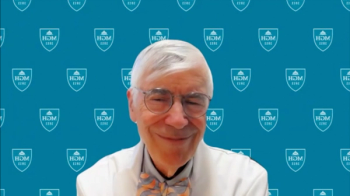
Robotic Surgery Offers Potential New Strategy for Hilar Cholangiocarcinoma Resection
A new report consolidates existing research on hilar cholangiocarcinoma resection, but finds more work is needed to better evaluate the efficacy of robotic surgery in these patients.
Robotic surgery may be the best option for patients in need of highly complex surgical resection operations for hilar
The report, based on 12 studies of patients with HC who underwent robotic surgery, was published in the journal
HC is a rare biliary cancer, with an estimated prevalence in Western countries of just 1.2 cases per 100,000 people, noted corresponding author Alberto Brolese, MD, of Provincial Agency for Health Services, in Trento, Italy, and colleagues. Unfortunately, the cancer type is also very aggressive, and by the time many patients experience symptoms, their chances for survival have diminished; the mean disease-specific survival is less than one year from diagnosis, the authors noted.
The only treatment for HC that is considered curative is surgical resection. Given the nature of the cancer, however, such surgeries are highly complex and difficult, Brolese and colleagues said.
“Oncological biliary tract resection is one of the most challenging abdominal procedures, with high rates of major morbidity and recurrence,” the authors wrote. “...The optimal surgical treatment for an oncological resection of HC is radical extrahepatic bile duct resection in conjunction with major hepatectomy, radical lymphadenectomy, and Roux-en-Y hepaticojejunostomy reconstruction.”
Robotic surgery, which has been used successfully for minimally invasive liver surgery, has been proposed as a potential solution for HC, but the investigators said its use in HC remains controversial.
In hopes of clarifying the situation, the authors conducted a systematic review of reports documenting cases in which robotic surgery was used to perform resection on patients with HC. They eventually found a dozen studies that included a total of 109 patients. All but one case series assessed patients based on the Bismuth classification of lesions. Of those who were classified, 21 had type I lesions, 7 had type II, 12 had type IIIa, 26 had type IIIb, and 4 had type IV.
The complexity of the surgery was underscored by the total operative time reported in the studies. Case reports and case series covering 21 total cases had a mean operating time of 644 minutes. Two other case series reported a median operating time of 375 minutes, with a median console time of 276 minutes.
The authors said patients lost an average of 662 milliliters of blood in the case reports and series for which data were available. Overall, one-third of patients needed blood transfusions. The overall conversion rate was 2.8%.
“Pooled postoperative morbidity and mortality was 39.8% and 1.8% respectively,”the investigators reported. “Mean LOS [length of hospital stay] for case reports and one case series for a total of 17 patients was 16 days.”
Eleven papers reported the R0 resection rate, which was 74.3%.
Seven studies reported oncological follow up, with median observation times ranging from 5 to 60 months. In those studies, which together included 19 patients, about half (10 patients) experienced recurrence within the follow-up period.
Brolese and colleagues said their review demonstrates that robotic surgery is safe, but they said the data was insufficient to draw conclusions about the overall benefits of robotic surgery versus non-robotic operations.
The authors said there are a number of factors that must be considered when determining whether to use robotic surgery on patients with HC, including patient characteristics and organizational factors. However, they said additional research is warranted in order to paint a clearer picture of the benefits—and potential drawbacks—of robotic surgery in these cases.
“The main criticism in the majority of series is the very long operative time. However, if surgery must become increasingly precise today, [robotic surgery] for the treatment of HC may become one of the best indications and potentially the most suitable tool for quality surgery,” they wrote.
Reference
Brolese A, Rigoni M, Pasquale A, Viel G, Brolese M, Ciarleglio FA. The role of robotic surgery for the treatment of hilar cholangiocarcinoma: A systematic review. Front Oncol. 2022;12:1001838. Published 2022 Sep 28. doi:10.3389/fonc.2022.1001838
Newsletter
Stay ahead of policy, cost, and value—subscribe to AJMC for expert insights at the intersection of clinical care and health economics.





























































